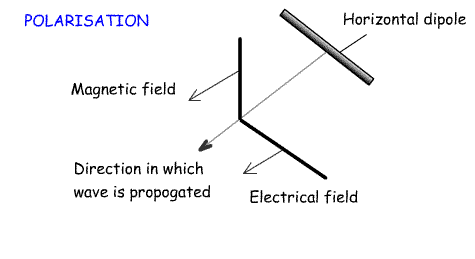
| ADVANCED LESSON 53 |  |
| LEARNING OBJECTIVES and NOTES | |
| Propagation - Electromagnetic Radiation | |
|
6a.1 Recall that an e-m wave comprises E and H fields in phase, at right angles and at right angles to the direction of travel. Recall that in circular polarisation, the polarisation of the wave rotates as it propagates, with either a right-handed (clockwise from behind) or left handed polarisation. Recall that this is often used for satellite communication where the orientation of the satellite is indeterminate. Recall that the transmit and receive antennas should have the same polarisation. At Intermediate level you learned that an electro-magnetic wave consists of an electric field and a magnetic field at right angles to each other. You also learned that when we talk about the polarisation we are talking about the electrical field. Not only can we have vertical polarised and horizontally polarised antennas, but we also have antennas where the polarisation is rotating. It can rotate in a right-handed (or clockwise direction)when viewed from behind or in a left-handed (anti-clockwise) direction when viewed from behind. Antennas for transmitting and receiving circularly polarised signals became popular when amateur satellites were first put into orbit. This is because the polarisation rotates as a satellite rotates and so a ground station needed to be able to follow this. With a vertical or horizontal antenna the signal from satellites tended to fade in and out. These antennas are also useful for working mobile stations where the whipping of the antenna and reflection from buildings and hills results in changing polarisation. The two common types of circularly polarised antennas are the crossed Yagi and and helical antennas, usually in their 2m, 70cm, 23cm versions. It is important that two stations using circularly polarised antennas have the same direction of polarisation otherwise there will be a high loss in signal. The loss between a vertical and antenna and a circularly polarised antenna is about 3dB. The same for a horizontally polarised antenna. This is acceptable. |
 |
| 6a.2 Recall that under free space conditions e-m waves travel in
straight lines and spread out according to an inverse square law of
power flux density and that that the field strength, measured in
volts/metre, drops linearly with distance. Numerical calculations required at item 7c1 only. The power flux density is the amount of energy that flows through a unit area per second. In free space where there is no reflection etc. an electro-magnetic wave will spread out in straight lines at the speed of light in all directions, creating an ever increasing sphere. The power at any point on this expanding sphere will be 1/d2 (inverse square law). The field strength, measured in volts/metre, drops linearly with distance. |